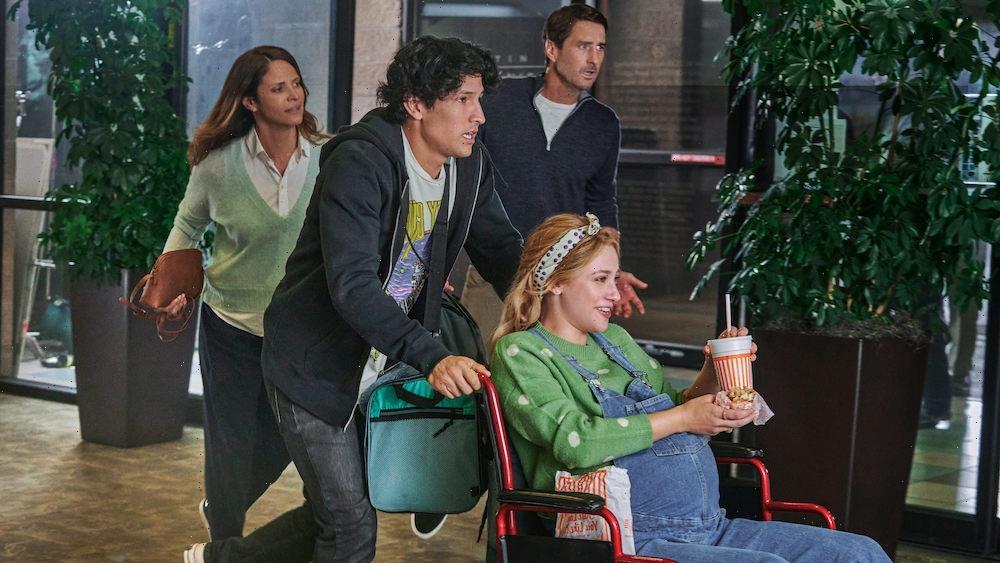In director Wanuri Kahiu’s “Look Both Ways,” a twentysomething woman is confronted with a pivotal situation that splits her life in two, eventually landing both versions of herself at a crossroads. The film mixes the conceits of “Sliding Doors” and “For Keeps” into one refurbished product, eschewing fantasy or melodrama in favor of grounded authenticity and levity. While the filmmakers’ heads and hearts are in the right place with their resonant sentiments on taking risks and embracing fate, their execution of narrative basics proves lackluster.
Natalie (Lili Reinhart) may look like an animated Disney princess, but her life is no fairytale. The soon-to-be college graduate has a five-year plan for success. Or at least she thought she did. She didn’t factor in the spontaneous sex she and friend Gabe (Danny Ramirez) had after finals, which leaves her puking her guts out and taking a pregnancy test at a rowdy graduation party. In the brief minutes it takes to get the results, she envisions her life splintering into two, with one version of herself pursuing her well-conceived plan and the other raising an inadvertently conceived child.
In one timeline, Natalie sets course for Los Angeles with her bestie Cara (Aisha Dee) to achieve her career ambitions in animation. She meets tall, handsome Jake (David Corenswet), who works for the company run by Natalie’s professional idol, character designer Lucy (Nia Long). And through this new boyfriend’s encouragement and tips, Natalie gets a gig working as her assistant.
In the other parallel universe, Natalie finds out she’s pregnant, moves back home with her shocked parents (Luke Wilson and Andrea Savage) and has the baby with Gabe, though refuses his marriage proposal. She defers her dreams of drawing and forgoes her friendships at the behest of motherhood. Complications ensue in both tracks, culminating in a predictable outcome.
Though Natalie experiences growth and is bestowed with complete, albeit imperfect arcs in both timelines, Kahiu and screenwriter April Prosser don’t give Cara one at all. Problems like her dissatisfaction with her job and friendship with Natalie are dealt short shrift, as is Cara’s positive romantic relationship with a new girlfriend. Their connective conflicts are rushed through and given a hand wave when earned emotion could easily be infused. As it is, the picture could stand a tighter run time as the second act sags, wallowing in the protagonist’s bouts of stress, sorrow and setbacks.
Gabe and Jake’s journeys are fraught with contrivances and conveniences that do their characters a disservice considering their roles as healthy, supportive influences on Natalie. There’s never any sense of genuine strife between Gabe and Natalie that doesn’t involve their romantic relationship and there’s nary any hardship (financial or whatnot) shown between them raising their small child. One diaper blowout does not adversity make. Natalie being the stereotypical commitment-phobe, rather than the guy, doesn’t help her agency, nor does it make the feature feminist. Both story tracks suggest that Natalie’s happiness essentially depends on a man returning to her life to complete her dream and teach her that she’ll be okay no matter which life she leads — a lesson that’s obvious to everyone in the audience.
While the feature falters narratively, it earns stronger marks on its technical merits. Kahiu and her collaborators give each timeline its own visual identity. Cinematographer Alan Caudillo and production designer Keith Brian Burns contrast Natalie’s worlds, rooting her surroundings in warm sunset hues in L.A. and cooler blue-gray palette in Austin. Costume designer Colin Wilkes also demarcates which Natalie we’re watching by her wardrobe: pink and purple in SoCal, versus blue in Texas. Drum & Lace and Ian Hultquist’s subtle synth score augments the mood and is masterfully utilized to bring out the emotional underpinnings in scenes, adding character.
Reinhart’s lead performance is tender, sweet and meaningful. She nimbly adapts to the material’s light and dark tones with nuance and vulnerability. She’s a strong screen presence whether alone or paired with multi-faceted actresses such as Long and Savage. What would be a generic, thankless role in anyone else’s hands is given depth and dimension by Long, as well as a sense of buoyancy. Savage combines a lighthearted wit and stirring wisdom in her brief screen time, imparting comfort and a slight comedic uptick.
Bookending the film using two aurally diverse covers of Fun’s pop song “We Are Young” is a smart way to reflect our two heroines and return us to the place where our journey began. The notions within the song are fittingly romanticized and ultimately blithe. However, the feature housing it is missing a necessary hook to make things sing.
Read More About:
Source: Read Full Article
